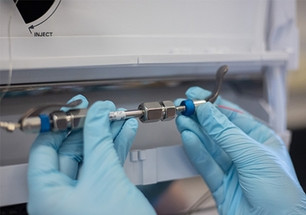Posted by Chrom Tech on 14th Oct 2025
Reduce Instrument Downtime with Sample Preparation
Reducing downtime in your chromatography lab not only maximizes productivity but also minimizes the costs of maintenance and instrument repair. One of the most effective ways to achieve this is by extending the lifespan of your HPLC columns through proper sample preparation and system protection. Clean, well-prepared samples prevent particulates and contaminants from entering the flow path, preserving column integrity and maintaining consistent performance over time.
In addition to sample prep, incorporating guard columns and inline filters into your system can significantly extend analytical column life. These components capture debris and particulates before they reach the main column. Since they are both affordable and easy to replace, they serve as the first line of defense—protecting your most valuable chromatography assets and ensuring smooth, uninterrupted operation.
Choosing the Right Sample Preparation Method
Different applications call for different sample prep approaches—from simple “dilute and shoot” techniques to more complex methods like Solid-Liquid Extraction (SLE) or Liquid-Liquid Extraction (LLE). Among the easiest and most cost-effective sample preparation methods is filtration. Filtering samples removes particulates that could clog columns or interfere with results, allowing for smoother chromatographic runs and longer instrument life.
Chrom Tech offers a range of filtration options tailored to different workflows:
- Centrifuge filter tubes — Ideal for processing multiple samples at once, offering a quick and efficient way to remove particulates before analysis.
- Syringe filters — Perfect for filtering smaller sample batches; simple, reliable, and always in stock for fast shipment.
- Filter vials — A convenient, all-in-one solution that integrates a filter, autosampler vial, and cap. Filter vials eliminate extra transfer steps and are fully compatible with autosamplers, reducing handling time and contamination risk.
By incorporating these filtration tools into your workflow, you can improve analytical precision, reduce instrument maintenance, and extend column longevity—all while maintaining high throughput and cost efficiency.
Conclusion
Implementing proper sample preparation techniques is one of the simplest ways to improve chromatography results and protect your instrumentation investment. Cleaner samples yield better chromatographic performance, more stable baselines, and longer-lasting columns. If you’re unsure which sample prep method is best suited for your application, connect with Chrom Tech’s experienced chromatography specialists for personalized guidance and recommendations.
Frequently Asked Questions About Sample Preparation
How does sample preparation extend HPLC column life?
Sample preparation removes particulates and contaminants that can clog or damage HPLC columns. Cleaner samples reduce backpressure, maintain peak efficiency, and extend the usable lifespan of analytical columns.
What is the best sample prep method for my application?
It depends on your sample type and analysis goals. Filtration methods such as syringe filters, centrifuge filter tubes, or filter vials are cost-effective for most general applications. More complex matrices may require extraction methods like LLE or SLE.
Why should I use a guard column?
Guard columns trap particulates and contaminants before they reach the analytical column. They’re inexpensive, easy to replace, and help maintain consistent chromatographic performance while reducing downtime and maintenance costs.

